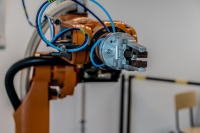However, the narrative isn't one of medical advancements. Instead, it is intertwined with serious health concerns and allegations of negligence. As we venture into the world of Bard PowerPort lawsuits, we learn about a variety of patient experiences and alleged defects.
This exploration delves into the intricate details surrounding the Bard PowerPort and its alleged association with health risks.
Bard PowerPort: A Brief Background
The Bard PowerPort, among various port/catheter systems, has been a creation of Bard Access Systems, Inc., a subsidiary of Becton, Dickinson, and Company (BD). Specifically, it serves as a completely implantable vascular access device.
It is designed to provide recurrent access to the vascular system for delivering medications, intravenous fluids, parenteral nutrition solutions, and blood products.
TorHoerman Law notes that the device's architecture consists of two core components. One is an injection port, where medication is introduced via a needle, and another is a polyurethane catheter. This catheter serves as the conduit through which medication enters the bloodstream from the port. The catheter serves the vital needs of patients requiring frequent and sustained vascular access for fluid administration or medication delivery.
Allegations and Concerns Regarding Bard PowerPort
The Bard PowerPort has found itself at the center of many serious allegations, each with potential repercussions for patient well-being and health outcomes.
According to ConsumerSafety, the many concerns about the device are:
- Catheter fractures and complications: While catheter fractures are relatively rare, they pose serious dangers. These fractures occur when the slender plastic tube within a vein splinters or breaks. It leads to issues such as medication leakage or fragments of the catheter becoming lodged in the vein.
- Catheter migrations: Some Bard PowerPort devices have been associated with catheter migrations, where the catheter shifts due to actions like coughing or vomiting. This dislodgment can trigger a cascade of further complications, leading to potentially dire consequences.
- Catheter infections: Infections linked to Bard PowerPort implantable ports have raised concerns. These infections can stem from a variety of factors, including catheter fractures or migrations. The severity of infections can vary, ranging from localized issues to more severe conditions like sepsis or septic shock.
Recall and Regulatory Response
JD Supra notes that as of this writing, the Bard PowerPort has not been subjected to a recall by its manufacturer. While some plaintiffs contend that the manufacturer should have initiated a recall, such actions have not been mandated by the FDA. However, the absence of a complete recall doesn't absolve the manufacturer from potential liability.
Instead, it raises questions about the establishment and maintenance of surveillance systems to promptly identify issues. There is also a need to inform consumers and the medical community about the associated product risks.
This regulatory response, or lack thereof, adds layers of complexity to the ongoing discussions surrounding Bard's safety and accountability.
Scope of the Lawsuit
LegalScoops notes that as of June 2023, the Bard faced a mounting legal challenge. There have been at least 10 individual lawsuits filed against the manufacturer of the product.
In a bid for efficiency and cohesive proceedings, a motion was filed on June 12 to consolidate these cases before the U.S. Judicial Panel on Multidistrict Litigation (JPML).
The decision to consolidate reflects the growing scope of the Bard PowerPort lawsuit. Plaintiffs seeking collective legal action to address the alleged issues make it a pivotal moment in this evolving legal landscape.
Patient Rights and Compensation
For patients impacted, the rights extend to seeking restitution for the physical, emotional, and financial toll they've endured. Compensation may include medical expenses incurred due to complications arising from the device, and potential economic losses and pain and suffering.
This pursuit aligns with patients' entitlement to fair and just compensation for the hardships caused by alleged defects. The evolving legal landscape aims to safeguard these rights, reflecting the overarching goal of upholding patient well-being. It aims to ensure that those affected receive appropriate recognition and support.
Conclusion
The Bard PowerPort lawsuit emerges as a stark reminder of the complexities inherent in the healthcare landscape. The journey of this legal battle unveils a narrative that intertwines patient well-being with regulatory responses and manufacturer accountability.
As the legal saga unfolds, it is a testament to the rights of patients to seek justice and fair compensation for alleged harm. The implications go beyond individual cases, prompting discussions about product safety, patient advocacy, and the need for stringent industry oversight.
Ultimately, the lawsuit underscores the ongoing pursuit of a balance between innovation and patient protection in the field of medical devices.















